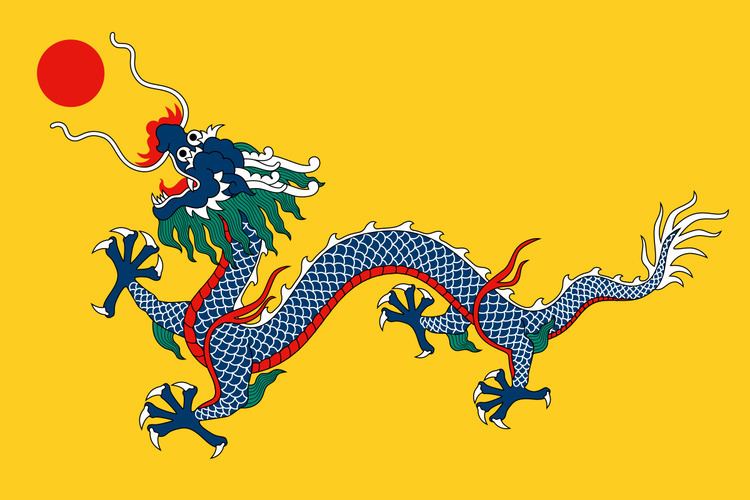Proportion 5:8 | Adopted 1889 | |
 | ||
Name Early version of Yellow Dragon Flag | ||
The flag of the Qing dynasty was an emblem adopted in the late 19th century featuring the Azure Dragon on a plain yellow field with the red flaming pearl of the three-legged crow in the upper left corner. It became the first national flag of China and is usually referred to as the "Yellow Dragon Flag" (simplified Chinese: 黄龙旗; traditional Chinese: 黃龍旗; pinyin: huáng lóng qí).
Contents
- Design
- Triangular version 1862 1889
- Rectangular version 1889 1912
- Influence
- Flags based on Qing dynasty flag
- References
Ruling China from 1644 until the overthrow of the monarchy during the Xinhai Revolution, the Qing dynasty was the last imperial dynasty in China's history. Between 1889 and 1912, the dynasty represented itself with the dragon flag.
Design
Throughout the history of China's imperial dynasties, yellow was considered the royal color of successive Chinese emperors. The legendary first emperor of China was known as the Yellow Emperor (Chinese: 黃帝, Simplified Chinese: 黄帝). Members of the imperial family of China at that time were the only ones allowed to display the color yellow in buildings and on garments. The Emperor of China usually used a Chinese dragon as a symbol of his imperial power and strength. Generally, a five-clawed dragon was used for emperors only.
In Chinese culture, a flaming pearl is shown on top of the dragon's head. The pearl is associated with wealth, good luck, and prosperity.
The design of the flag was largely based on the Plain Yellow Banner of the Eight Banners.
Triangular version (1862-1889)
The Arrow Incident of 1856 occurred as a result of Chinese civilian vessels flying foreign flags as the Qing dynasty had no official flag at the time. In 1862, sailors from the Chinese and British navies clashed at Wuhan on the Yangtze River. In response to the British navy's claim of being unable to distinguish between Chinese governmental or navy ships and civilian vessels, Yixin (Prince Gong) urged Zeng Guofan to create a governmental flag for the Qing, and suggested use of a yellow dragon flag, which was also used as one of the Eight Banners of the Manchu as well as in the Chinese army. After due consideration, Zeng Guofan concluded that a square flag bore too close a resemblance to the Plain Yellow Banner of the Eight Banners with the potential to be viewed as an endorsement of the Eight Banners hierarchy, he instead removed one corner to create a triangular flag.
The triangular version of the yellow dragon flag was restricted to naval and governmental use only, no civilian ships were permitted to fly the yellow pennant, and it never became the national flag. However, on some diplomatic occasions and at international exhibitions, this flag was used to represent China.
Rectangular version (1889-1912)
In September 1881, when the two cruisers Chaoyong and Yangwei ordered from Birkenhead, England were sent to China, Li Hongzhang realized a triangular ensign was unique among naval flags of other countries. As a result, he petitioned the imperial court for permission and subsequently altered the triangular naval flag into a rectangular one.
Seeing Western countries flying national flags on official occasions, Li Hongzhang also asked Empress Dowager Cixi to select a national flag for the Qing dynasty. Among the proposals for use of the Ba gua flag, the Yellow dragon flag and the Qilin flag, Cixi selected the Yellow dragon design. In 1888, the imperial court promulgated the naval flag as the Qing national flag.
Influence
The notion of yellow as representative of Manchu ethnicity was used in the flags of the Five-coloured flag of the Republic of China and on the flag of the Empire of China, although in 1912 the former was challenged by Sun Yat-sen, who thought it inappropriate to use the traditional imperial color to represent Manchu ethnicity. Also, mustard yellow was used in the flag of Manchukuo in deference to the Qing dynasty, on whose flag it was based.
The blue dragon was featured in the Twelve Symbols national emblem, which was the state emblem of China from 1913-1928.
Flags based on Qing dynasty flag
Navy of Qing dynasty adopted the national flag in the canton of naval flags in 1909.
Flag of Chinese Eastern Railway adopted a combination of Qing dynasty and Russian flags. The flag was not updated until 1915.
